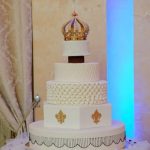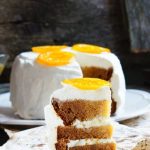Are you looking to learn how to decorate a cake using fondant? Fondant has become a popular choice for cake decorating due to its versatility and smooth, polished finish. In this article, we will explore the basics of fondant and why it has gained popularity among bakers and cake decorators. From preparing the cake to adding the final touches, we will provide you with step-by-step instructions and tips for achieving professional-looking results.
Fondant is a type of icing that can be rolled out into a thin, flexible sheet and draped over a cake for a flawless finish. It allows for endless creativity in terms of design and decoration, making it an ideal choice for special occasions such as weddings, birthdays, and other celebrations.
Whether you’re a beginner or an experienced baker looking to expand your skills, mastering the art of fondant decorating is sure to elevate your cakes to the next level.
In this comprehensive guide, we will cover everything from choosing the right type of cake for fondant decorating to troubleshooting common issues that may arise during the process. You’ll also learn how to add texture and designs to your fondant-covered cakes as well as create beautiful fondant decorations to enhance their appearance. With our expert tips and techniques, you’ll be able to confidently decorate your cakes using fondant like a pro.
Preparing the Cake
When it comes to decorating a cake with fondant, the type of cake you use can make a big difference in the final result. Choosing the right type of cake is crucial for ensuring that the fondant adheres properly and that the overall texture and flavor complement the sweet and malleable nature of fondant. Here are some tips for selecting the perfect cake and preparing it for fondant decorating.
Choosing the Right Type of Cake
Not all cakes are created equal when it comes to fondant decorating. The ideal cake for using fondant is one that is dense and firm, such as a pound cake, sponge cake, or mud cake.
These types of cakes provide a sturdy base for the weight of the fondant and are less likely to crumble or collapse under its weight. Avoid light and fluffy cakes like angel food or chiffon cakes, as they may not support the structure of the fondant.
Preparing the Cake
Before applying fondant to your cake, it’s essential to ensure that it is level, smooth, and well-structured. Trim any uneven or domed tops from your cake layers to create a flat surface for decorating. Then, apply a thin layer of frosting or ganache to seal in any crumbs and create a smooth surface for the fondant to adhere to. Let this layer set before adding your fondant covering.
Avoiding Moisture
It’s important to note that moist fillings like whipped cream or fresh fruit can cause issues when used with fondant as they can cause sweating between the layers. To avoid this problem, consider using thick buttercream or jam fillings in conjunction with a dam of stiff buttercream around the edges to prevent moisture from seeping into your cake layers.
By following these tips for choosing and preparing your cake for fondant decorating, you’ll be on your way to creating beautiful and professional-looking cakes that not only taste delicious but also look stunning.
Rolling Out Fondant
- Prepare your work surface: Before you start rolling out the fondant, make sure to prepare your work surface by dusting it with powdered sugar or cornstarch to prevent sticking.
- Knead the fondant: To make the fondant more pliable and easier to work with, knead it gently for a few minutes until it becomes smooth and elastic.
- Roll out the fondant: Once the fondant is ready, use a rolling pin to roll it out into a smooth, even circle that is about 1/8 inch thick and larger than the size of your cake. You can use spacers or guides on either side of your fondant when rolling it out to ensure an even thickness throughout.
- Lift and cover: Carefully lift the rolled-out fondant using a rolling pin or by draping it over both of your hands, then gently place it over your prepared cake. Smooth out any wrinkles or air bubbles using a fondant smoothers, starting from the top and working your way down along the sides of the cake.
Remember that practice makes perfect when it comes to rolling out fondant, so don’t get discouraged if you don’t get it right on your first try. Experiment with different techniques and tools until you find what works best for you.
Covering the Cake
Covering a cake with fondant can be a daunting task, but with the right techniques, it can be achieved smoothly and flawlessly. When it comes to covering the cake with fondant, there are a few key steps to keep in mind to ensure a professional finish.
Preparing the Cake
Before applying fondant, it’s crucial to prepare the cake properly. Start by ensuring that the cake is level on top to provide a smooth surface for the fondant. You can trim any uneven edges with a serrated knife and fill in any gaps or holes with buttercream or ganache before covering the cake with fondant.
Once your cake is prepared, it’s essential to brush a thin layer of simple syrup or piping gel onto the cake’s surface. This will help the fondant adhere to the cake and prevent air bubbles from forming underneath.
Rolling Out Fondant
When rolling out fondant, make sure to dust your work surface and rolling pin lightly with powdered sugar or cornstarch to prevent sticking. Roll the fondant into a large circle, keeping it about 1/4 inch thick for easy handling.
To determine if your rolled-out fondant is large enough to cover your entire cake, you can use a piece of string or ribbon to measure across the top of your cake and down its sides. Ideally, you want an extra 2 inches all around for draping over curves.
Covering the Cake
Gently lift one edge of the rolled-out fondan and drape it over the top of your prepared cake. Smooth out any air bubbles by gently pressing down on the fondant starting from the top of the cake and working your way down towards the base.
Use smoothers to achieve crisp edges and smooth surfaces without causing any wrinkles in your fondant. Trim off excess fondnat at teh base of teh caek wth a sharp knife or pizza cutter for as clean finish.
Adding Texture and Designs
Once you have successfully covered your cake with fondant, it’s time to get creative and add some texture and designs. One popular method is to use molds to create intricate patterns on the fondant. These can range from simple geometric shapes to more complex floral or lace designs. To use a mold, lightly dust it with cornstarch or powdered sugar, press it firmly onto the fondant, and then carefully remove it to reveal the design.
Embossing tools are another great way to add texture and detail to fondant. These tools come in a variety of shapes and sizes, allowing you to create lines, dots, or other patterns on the surface of the fondant. Simply roll the embossing tool over the fondant gently but firmly to leave an impression.
Using cutters is a versatile way to add designs to your cake. From creating decorative edges for the cake to making shapes that can be layered or arranged in different ways, cutters allow for endless creativity. You can also layer different colored pieces of fondant together using cutters to create custom designs.
These methods provide countless opportunities for customization and personalization when decorating a cake with fondant. Whether you want a sleek modern look or something whimsical and fun, using molds, embossing tools, and cutters allows you to achieve your desired decorative outcome.
| Method | Description |
|---|---|
| Molds | Create intricate patterns by pressing mold onto fondant |
| Embossing Tools | Add texture and detail using various shaped tools |
| Cutters | Create decorative edges or layered shapes with different colors |
Creating Fondant Decorations
Decorating a cake with fondant opens up a world of creative possibilities, and creating simple fondant decorations can take your cake to the next level. Whether you want to add delicate flowers, fun shapes, or cute figures, working with fondant allows you to bring your imagination to life. Here are some tips for making simple but stunning fondant decorations:
- Choose the Right Tools: Before you start creating fondant decorations, make sure you have the right tools on hand. This includes a rolling pin, fondant shaping tools, embossing mats, and cutters in various shapes and sizes.
- Coloring Fondant: If you want your decorations to have vibrant colors, it’s important to use gel food coloring specifically designed for fondant. Knead the coloring into the fondant until it reaches your desired shade.
- Making Flowers and Shapes: To make flowers, start by rolling out small balls of colored fondant and flattening them into petal shapes. Then layer the petals on top of each other and finish with a small ball of contrasting color for the center. For shapes like hearts or stars, use cookie cutters to cut out the desired shape from rolled fondant.
Creating fondant decorations can be a fun and rewarding part of cake decorating, allowing you to personalize your cakes for any occasion. By following these tips and getting creative with colors and shapes, you can enhance the appearance of your cake and impress your guests with beautiful custom decorations made from fondant. With practice and patience, you’ll soon be able to create an array of stunning fondant decorations to adorn your cakes.
Troubleshooting
When decorating a cake with fondant, it’s not uncommon to encounter some issues along the way. One common problem is cracking, which can happen when the fondant dries out too quickly. To prevent this, make sure your cake is covered with a thin layer of buttercream or simple syrup before applying the fondant.
This will help keep the cake moist and prevent the fondant from drying out too fast. If you do notice cracks forming as you work with the fondant, use a small brush to apply a little bit of water to the cracked area and gently smooth it out with your finger.
Tearing is another issue that many bakers face when working with fondant. This can occur if the fondant is too thin or if it’s stretched too much while being applied to the cake. To avoid tearing, roll out your fondant to an even thickness and use gentle, even pressure when covering the cake. If tearing does occur, gently press the torn edges back together and smooth them out with your fingertips.
Sticking can also be a problem when working with fondant, especially in warm or humid environments. If you find that your fondant is sticking to the work surface or rolling pin, lightly dust both surfaces with powdered sugar or cornstarch to prevent sticking. Additionally, make sure your hands are clean and dry when handling fondant to avoid any unnecessary sticking issues.
| Common Issue | Solution |
|---|---|
| Cracking | Prevent by keeping cake moist before applying fondant; if cracks form, apply water and smooth |
| Tearing | Roll fondant evenly and apply gentle pressure when covering cake; press torn edges together gently |
| Sticking | Dust work surface and rolling pin with powdered sugar/cornstarch; keep hands clean and dry while handling |
Finishing Touches
In conclusion, decorating a cake using fondant can be a fun and creative process that allows for endless possibilities when it comes to design and customization. By following the steps outlined in this article, anyone can achieve professional-looking results right at home. From choosing the right type of cake and preparing it for fondant decorating to adding final touches with edible colors, glitter, or royal icing, each step is crucial to achieving a stunning finished product.
One of the key takeaways from this article is the importance of patience and practice when working with fondant. Covering a cake with fondant can be challenging for beginners, but with the right techniques and troubleshooting tips, even the most common issues like cracking or tearing can be easily fixed. Additionally, adding textures and designs using molds, embossing tools, and cutters can really take a cake to the next level, giving it an elegant and professional appearance.
Ultimately, whether you’re decorating a cake for a special occasion or just for fun, using fondant opens up a world of possibilities for creativity and personalization. With the tips provided in this article, anyone can learn how to beautifully decorate a cake using fondant and impress friends and family with their artistic skills. So don’t be afraid to experiment with different techniques and decorations – the end result will surely be worth the effort.
Frequently Asked Questions
How Do You Use Fondant on a Cake for Beginners?
Using fondant on a cake for beginners involves first rolling out the fondant to the desired thickness, then carefully lifting and draping it over the cake. Smooth out any air bubbles or wrinkles with a fondant smoother or your hands. Trim any excess fondant from the bottom of the cake and use fondant tools to add details or decorations.
How Do You Get Fondant to Stick to a Cake?
To get fondant to stick to a cake, you can use buttercream or piping gel as an adhesive. Simply apply a thin layer of either buttercream or piping gel to the surface of the cake before placing the fondant on top. This will help the fondant adhere to the cake and prevent it from sliding off.
What Do You Put on a Cake Before Fondant?
Before applying fondant, it’s important to put a layer of buttercream or ganache on the cake. This layer not only helps the fondant stick to the cake, but also provides a smooth surface for the fondant to adhere to. Make sure that the buttercream or ganache is evenly spread and chilled before adding the fondant on top.

Welcome to my blog about home and family. This blog is a place where I will share my thoughts, ideas, and experiences related to these important topics. I am a stay-at-home mom with two young children. I hope you enjoy reading it! and may find some helpful tips and ideas that will make your home and family life even better!





